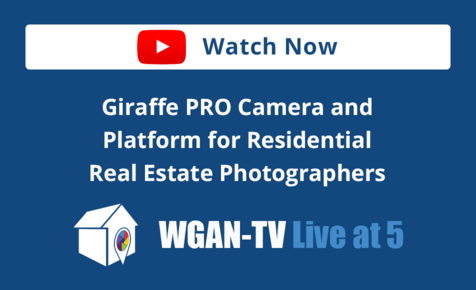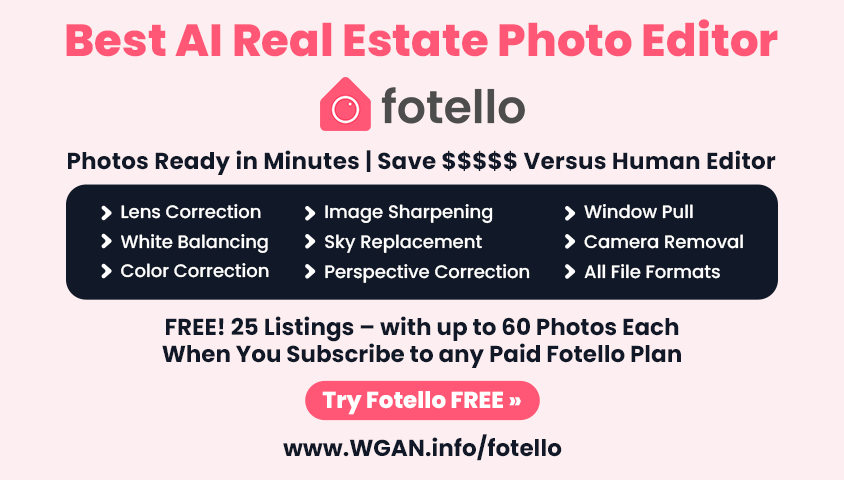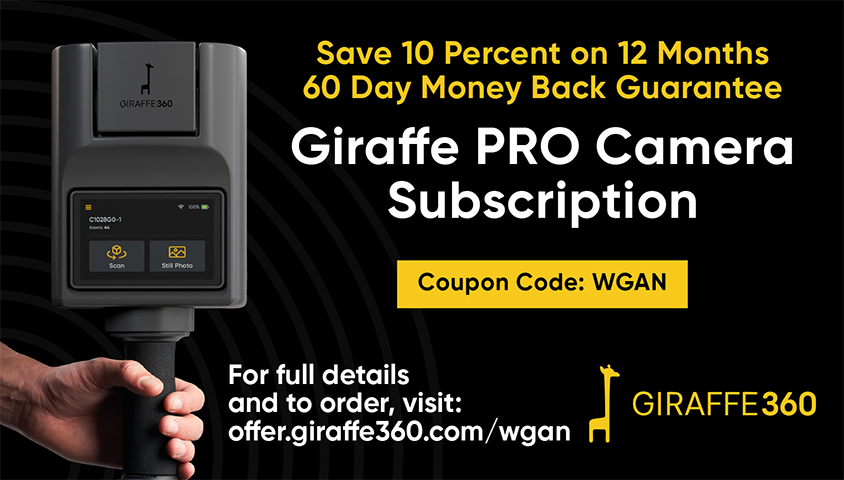1st PoV Matterport Pro3 Camera Warehouse Scan w/ High-Density Data Capture21044
Pages:
1
 WGAN Forum WGAN ForumFounder & WGAN-TV Podcast Host Atlanta, Georgia |
DanSmigrod private msg quote post Address this user | |
| WGAN-TV Podcast: 1st PoV Matterport Pro3 Camera Warehouse Scan with High-Density Data CaptureWGAN-TV Podcast: Video by WGAN-TV Podcast Co-Host Tom Sparks. Tom is also Founder and CEO of Scan Your Space (a Division of Sparks Media Group) @ScanMySpace Episode 259 | Wednesday, 30 July 2025 Matterport Warehouse Scan Example (High-Density Data Capture) courtesy of Tom Sparks, Founder and CEO of Scan Your Space (a Division of Sparks Media Group) WGAN-TV Podcast: 1st PoV Matterport Pro3 Camera Warehouse Scan with High-Density Data Capture ==================================================================== e57 File | Matterport Pro3 Camera High Density Warehouse Scan by Tom Sparks ==================================================================== Hi All, -- Are you wondering what it’s like to scan a space with a Matterport Pro3 Camera? -- Would you like to see the process from a first-person point of view? -- How long does it take to complete a high-density scan with the Pro3? Stay tuned… In this episode of the WGAN-TV Podcast, WGAN-TV Podcast Guest Host Tom Sparks, Founder and CEO of Scan Your Space, walks us through a high-density scan of a warehouse using the Matterport Pro3 Camera. Filmed from a first-person PoV, Tom gives us a realistic look at the workflow, timing, and strategy for capturing accurate data in an industrial setting. You’ll see: ✓ How long a high-density Matterport Pro3 Camera scan actually takes (over 2 minutes per scan point) ✓ A scan-by-scan progression in real time (15 scans total) ✓ Real talk about when to charge by square foot vs. by time on site ✓ Pricing strategies based on gear, market, and skillset ✓ Firsthand insights into high-pressure commercial scanning ✓ Why using your own portfolio (not others' Tom also explains why he uses only the Matterport Pro2 Camera and Matterport Pro3 Camera for Matterport work, shares insights from years of experience, and gives advice on handling client expectations when scanning complex or high-stakes environments. Want to buy a Matterport Pro3 Camera via Amazon? → www.WGAN.info/matterport Have questions for Tom or want to hire him to scan or consult? ✓ Visit: www.SparksMediaGroup.com or www.ScanYourSpace.com ✓ Ask questions in the We Get Around Network Forum ✓ Subscribe to Tom’s YouTube Channel: @SparksMediaGroup Catch all past WGAN-TV Podcast episodes at www.WGAN-TV.com or in your favorite podcast app. Thanks for watching this episode of the WGAN-TV Podcast. Best, Dan --- Transcript (video above) Are you wondering what it's like to scan a space with a Matterport Pro3 Camera. Would you like to see the scanning from a first-person point of view? How long does it take to do high-density data capture with a Pro3? Stay-tuned ... Hi All, I am the digital twin of Dan Smigrod, Founder of the We Get Around Network Forum. You're watching a special edition of the WGAN-TV Podcast for digital twin creators shaping the future of real estate today. We have a great "how to" episode for you! Our WGAN-TV Podcast Guest Host is Tom Sparks, Founder and CEO of ScanYourSpace, a division of Sparks Media Group. Tom will show (and tell) us about using a Matterport Pro3 Camera to scan a warehouse. Tom also provides tips of how to charge and why, including when to charge by time and when to charge by the square foot. Want to buy a Matterport Pro3 Camera via Amazon? Go to: WGAN.info/matterport. - [Tom] Hey everybody. Tom Sparks with Sparks Media Group. In this video, we're going to use the Matterport Pro3 Camera, and we're going to capture this warehouse room anyway. We're not doing the whole industrial space, just this particular room for the purposes of getting the data file and comparing them. And so I'll show the process. The first step we want to do is make sure we're connected to the Matterport SSID with wifi, and we are. Next, we're going to open Matterport, and then we're going to create a new job. Now on this scan, I'm going to do a high density, because I want to compare the max end of what this can do. I think on a previous scan of this space, I did the standard density. So we're going to do a high density, it's going to take about two minutes to gather data, and we will time that. So I'm going to start my countdown and we're going to hit start right now. Now, if I'm not mistaken, normally a scan with the Pro3 is right around 27 seconds or so. So we're at two minutes, seven seconds for the scan and then to download. Let's see here. All right, we had two minutes, seven seconds for the scan, and then an additional 21 seconds to download the data. That's a lot. So here poses a question. When doing scans for non-residential, for the purposes of getting a data file, do you charge by the time on site? Because two minutes a scan, two and a half minutes a scan is a lot longer than 27 seconds, or are you charging by the scan square foot? I think if a client is expecting a higher end point cloud file or higher end data, top of the line, top shelf data, you would charge maybe by time on site, whatever that is. And if it's just a regular scan for non-data purposes, just for marketing or facilities management or anything like that, maybe charge by square foot. Pricing for this type of work really is based on a bunch of different factors. It's based on the market that you're in. It's based on how much competition you have in the area. It's based on your skillset. Let's kind of break this down little by little. The market you're in, where I'm at, it's the San Francisco Bay Area, Silicon Valley, the heart of nerds. And so people want really rich data. They probably care about super accurate data, I would say more so than somebody who's in, I don't know, Butte, Montana for example. And not to say anything about people in Butte, Montana, but I know for a fact that, okay, let's take Texas. I have a photographer in Texas and what we're able to charge clients out there is less than what we're able to charge clients out here. So when people get on a forum and they say, hey, I'm getting ready to start learning how to scan, what should I charge? Those questions are kind of pointless because you're going to get 97 different answers based on the market alone. Now let's figure out what your time is worth. When I started working, way back in the day when I was 15 years old, I was making $4.25 an hour, and you can't do anything with $4.25 an hour nowadays. I have a family member who is in the medical field. They make roughly $50 to $60 an hour. I've done jobs where I've charged $50 an hour. I've done jobs where I've charged $300 an hour, and I've done jobs where I've charged a thousand an hour. It really just depends on the client, the budget, the use case, what tools are needed. You take this camera here, it's, let's just say $5,000, $6,000. Compare it with some of the higher end cameras that can go up to $110,000. So the quality of your equipment is also going to determine what you charge. Sorry, I couldn't get that out. So what's your time worth? I had a client who asked me to go do a job and it was maybe an hour away and they wanted to pay, let's just say $150. I'm not getting out of my bed for $150 to drive an hour each way, but that's me. There might be people that are willing to do that. Now let's talk about skillset. I've been doing this a while and I tell people all the time kind of in a joking manner, but it's true. I feel like I'm the Liam Neeson of this. I have a unique skill set. I can walk in this room and know exactly where I'm going to place the scan points. They may seem random to some people, but they're very purposeful. And so, anybody can press a button and make the camera work. I've had a client who said, I was hired to do a Matterport of a house. This was a real estate agent. And I was in and out of this 2,000 square foot house in about, let's just say 35, 40 minutes with Matterport. And the client was just flabbergasted. She said, oh, the last house I had, this other photographer took six hours to do a Matterport, and I thought she was joking. I said, what were they doing, taking a nap and eating a sandwich? Now, Matterport is kind of unique because they support a bunch of cameras that aren't their own. So when we're offering 3D tours with Matterport, I'm only using the Matterport Pro3 Camera and I might use the Pro2 depending on the use case. But we have several Matterport Pro3 Cameras that me and my crew use, and that's all we're offering. We're not offering any of the other 360 cameras. We're not offering the AXIS system because I don't feel that the quality is up to par with what the Matterport Pro3 Camera can deliver and the Matterport Pro2 Camera for that matter. So maybe that other photographer had, let's say the AXIS and he was using his phone, well, it's going to take longer than using the Pro3. And a lot of clients don't care, or maybe they don't know, they just know Matterport. They don't know what kind of camera you're using. And so it's up to you as the person providing the service to educate them. Well, hey, if you want a really high accurate data file, you're not going to get that with your smartphone or with one of the 360 cameras. You're not even going to really get that from the Pro2, you're going to want the Matterport Pro3 Camera. Well, if you're a person offering Matterport who doesn't have a Pro3, and you get a client who says, hey, I need a Matterport scan, your first response is, yeah, I can do it. And then when you find out what they need, you're kind of going to paint yourself into a corner because you're not going to be able to offer that if you have a non-Matterport Pro3 Camera type camera. So that's all kind of boiled into a skillset and maybe even equipment. We'll put those in those categories. How efficient are you at doing your job? Practice makes perfect, and as you practice, practice, practice, you get better, better, better. Think about when you, I don't know, what would be something that takes a lot of time at the beginning when you're first starting it, but as you go, you get better at it. It reduces the time. First thing that's coming to my mind is sewing, maybe making a blanket. I remember my grandmother tried to teach me how to crochet and I got like, from what I remember, one little like strand, one little row done. And it seemed like that took me forever. Well, she sat there and she was legally blind. She had an eye condition that caused her to lose her sight and she was able to crochet by feel and she was running laps around me. Well, she had been doing it for 40, 50 years and I had just did it for maybe 30, 40 minutes. So not everybody's going to charge the same just based on that. If you're a client who's okay with somebody doing a Matterport tour and staying in your space for eight, nine, 10 hours, yeah, maybe you'll save some money because they're going to charge you less. Whereas with me, I can get in and get out. Time is money and time matters. And there's not a lot of clients who are okay with tying up their space for that long of a period of time. So I'm going to charge more for that. We do a lot of hotel shoots, we do a lot of retail spaces and those spaces can't be shut down for hours on end. And so you really have to know what you're doing. It's a high pressure situation. I've brought on several photographers lately who were new to doing Matterport and I've thrown them in situations and it's interesting to see how they handled it. Where it's like, okay, we really have to get through this space efficiently. You don't have time to double check your work, just get it done. Get it done right obviously, but then get out of the space. Everybody messes up. But I can confidently say that I rarely have to make return visits to sites because I've messed up a space, didn't scan enough, missed a few spaces, that sort of thing. So skill, having the skill, you're going to end up charging a little more for that than if you don't have the skill. What else can we talk about? Yeah, pricing is just, there's so many variables to it. Even with this client I have here on Mare Island, CA every space that I quote them is different. It's not a cookie cutter, this is what I charge. I try to have like a base minimum. And then depending on how the space is laid out, there's going to be a different charge. This is really open and I don't remember the square footage, but we'll have it here shortly. This space is going to take a different amount of time than a similar size space that's maybe divided into a bunch of smaller rooms, a lot more walls, a lot more things to work around, a lot more scan points. So again, every space is a little different. Geez, we're working on our sixth scan point, I guess that has been about 12 minutes or so. I will say, Matterport charges, what they charge for CAD files, BIM files, that sort of thing. I've tested out some third party vendors, just a few so far. And there's so much variation in the data that they're coming back with that once you find somebody you're happy with to process your data, if it's not going to be Matterport, you should stick with them. Don't bounce around from vendor to vendor because just the variation of the deliverables that they're giving is, there's a lot out there. Now with Matterport, we're going to mark windows. Here's something I learned was pretty efficient. I think one of my photographers, Keith, taught me this: use your Apple Pencil. It was either Keith or Marcus. I think it was Marcus maybe. You can mark your windows pretty efficiently. Oh, I'm going to go off on kind of a little bit of a tangent here. In some of the posts online regarding Matterport, I see a lot of Matterport users who frequently will say, hey, I'm getting ready to scan an auto dealership. Does anybody have an example I can show the client? Or hey, I want to pitch to baseball stadiums. Does anybody have an example? And I think Matterport has a gallery on their website of different spaces that might be free to use, but I would really caution anybody from using work that's not theirs. And the reason is, is because you don't know what kind of camera they're using, you don't know how long they've been in business. That tour could have them in reflections on mirrors or windows, and that's not a good look. And at the end of the day, it's just not your work. I come from a photography background and I would never create my website and say, hey, hire me for your next family shoot or wedding or whatever the shoot is. Here's samples of my work. And then post other photographers' work. That's just a really big no-no. And so I treat Matterport scans similarly. I am creating this space. I'm the photographer who is capturing this space. This is my work. So if anybody was to want to use that to pitch to a client, it's just bad form. Go out and do some free scans, hustle up some clients and put in the work. I had a really big global client reach out to me based on my YouTube Channel . And I laughed because this story is frustratingly funny. The client saw my videos, reached out and said, hey, we have a project in another country we need scanned. Can you do it? And I said, sure. So they wanted to hop on a call. So we get on a call and I'm telling them, kind of a little bit about me, what I do, how I do it, based on what they told me about their project, how long it would take. And the call went well, it was like a vice president of something and whoever needed the scan done, which was, the vice president was their boss. So at the end of the call they say, yeah, well, we're talking to a few other providers, which is understandable. Get quotes, I'm not mad at that. They then said, do you have examples of this type of space? And it was pretty specific. Well, I've done millions of square feet of scanning, thousands of tours. You found me from my YouTube Channel and you want to see samples of this very specific type of place? I didn't have one to share with them, not because I hadn't done it, just because for confidentiality reasons I can't share everything that I do and I don't share everything that I do. Think about this, I shoot every single day, six days a week, not every single day, six days a week. I try to take one day off. My team shoots pretty much every day. So, we're doing a lot of work. So I didn't have anything to share with this client. So I sent them some other examples that were very similar, just not specifically what they were looking to get done. And then I gave him the quote and the quote was to cover my airfare and my hotel stay and then my rate. And I told some family members who aren't familiar with scanning about what I quoted, and they were like, well, you must not want the job because you quoted them too much. Okay, well you don't do this work, so you wouldn't know what that price should look like. So a couple weeks later, I hear back from the client and they went with another vendor. And I wasn't too concerned that it was because of price, just because I knew what this company wanted and there was some time constraints. It was a space that was going to be occupied 24/7 by people and they wanted nobody in the scans. So there's a little bit of what I call a PITA tax, a pain in the ass tax that I added on because of the fact that I'd have to work around people and wait for them to walk by and that sort of thing. So anyway, I quoted the rate, they went with another vendor. It wasn't because of my rate, which was good to know. They went with another vendor because that vendor showed them an example of the space that they specifically wanted to see. And I just was shaking my head because I had no doubt that I could have captured that space efficiently and in the way that they needed. I just couldn't show them an example. And I thought it was a little nearsighted on the client, but I get it. If you want to see what you want to see, then that's what it is. But yeah, I missed out on that opportunity, which was unfortunate. But other opportunities have came up since. And I'm blessed so I'm not going to cry over spilled milk. So all of that to say, don't use other people's examples and pass it off as your own. Just not a good look. Okay, we're back. We overheated the GoPro and we're working on scan 14 right now. About halfway done with 14. Then we'll see. I think I'm going to do one in the center of the room and we will see what else after that. Trim that out. I think we got enough coverage. I'll just do one more in the center here. All right. So 15 scans. We have this space captured with the Matterport Pro3. Stay tuned for the data file. Thanks Tom! Got follow-up questions for Tom or want to engage Tom to scan or consult? Go to www.SparksMediaGroup.com or www.ScanYourSpace.com or post your questions to the We Get Around Network Forum at www.WeGetAroundNetworkForum.com. Also, subscribe to the Sparks Media Group YouTube Channel: @SparksMediaGroup. For all WGAN-TV Podcast episodes, look for WGAN-TV in your favorite podcast app or go to: www.WGAN-TV.com. Thank you for watching this episode of the WGAN-TV Podcast. |
||
| Post 1 • IP flag post | ||
Pages:
1
















